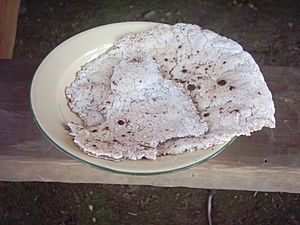Papua New Guinean cuisine facts for kids
The cuisine of Papua New Guinea (often called PNG) is all about the traditional and varied foods found in the eastern part of the New Guinea island. About 80% of the people in Papua New Guinea grow their own food. This means most of what they eat comes from their own farms. The main foods include root crops like sweet potato, bananas, and sago. Many people in PNG eat a lot of vegetables, especially in the Gulf and Highlands areas.
Mumu is a very old and special way of cooking big meals in Papua New Guinea. It's also used on other Pacific islands. A mumu uses an earth oven. This is a pit dug in the ground, filled with hot coals or stones. Food is placed inside and cooked slowly for a long time. Even though modern ovens exist, mumu cooking is still very popular in homes across PNG.
Contents
Drinks in Papua New Guinea
Just like other islands in the western Pacific, kava is a popular drink. It's made by mixing the root of the kava plant with water. It's a non-alcoholic drink.
Coffee is a very important crop for Papua New Guinea. It's the country's second biggest farm export, after oil palm. Most coffee is grown in the Highlands Region. Because of this, coffee is a widely enjoyed drink across the country. Besides non-alcoholic drinks, beer is an alcoholic drink that many Papua New Guineans like.
Main Foods (Staples)
Sago is a key part of Papua New Guinean cooking. This starchy ingredient is used in many traditional dishes, like pancakes and puddings. Sago flour usually comes from the sago palm tree.
Other main foods in Papua New Guinea include karuka (a type of nut), sweet potato (called kaukau), cassava, breadfruit (called ulu), and coconuts. Coconut cream is a special ingredient often used in many local dishes. People living near the coast often cook with coconut milk and cream. In the Highlands, they don't use it as much. Coconut oil is also used for special meals in coastal areas.
People in Papua New Guinea don't eat meat every day. But for those living near the coast, seafood is a big part of their diet. Pork is seen as a special meat. It's cooked for celebrations, like Christmas feasts.
Famous Dishes
- Mumu is considered the national dish of Papua New Guinea. It usually has pork, sweet potato, rice, and other vegetables. Mumu is a balanced meal with both plants (like starchy foods) and meat. The dish gets its name from the earth oven used to cook it.
- Chicken pot is a dish made with chicken stewed with mixed vegetables and coconut cream.
- Kokoda is a fish dish cooked in a sauce made with lime and coconut. It's similar to a dish called ceviche. You can also find Kokoda in Fijian cuisine.
- Saksak are dumplings. They are made from banana, ground sago, and sugar. This mixture is wrapped in a banana leaf and then steamed.
- Dia is a dessert. It's made from sago and bananas cooked in coconut cream. Sometimes, sugar isn't added. Instead, sweeter bananas are used to make the dish taste good.
Food Influences
When Europeans first came to Papua New Guinea in the 1500s, it was the first time foreign foods were brought in. In the 1800s, European settlers brought new animals and crops. These new foods became very important for trade.
Papua New Guinea's food and traditions have also mixed with those from Indonesian New Guinea and other Pacific countries. For example, the dish kokoda, which is fish cooked in lime and coconut sauce, is also a popular dish in Fijian cuisine.
Fast Food in PNG
There are not many fast food restaurants in Papua New Guinea. The fast food chains you can find include Hog's Breath Cafe (an Australian steakhouse chain), Big Rooster (a local chicken shop chain), and Eagle Boys (an Australian pizzeria chain). There are no big American fast food chains in Papua New Guinea. All the fast food places are either owned locally or by Australian companies.
See also
- Oceanic cuisine
- Culture of Papua New Guinea


